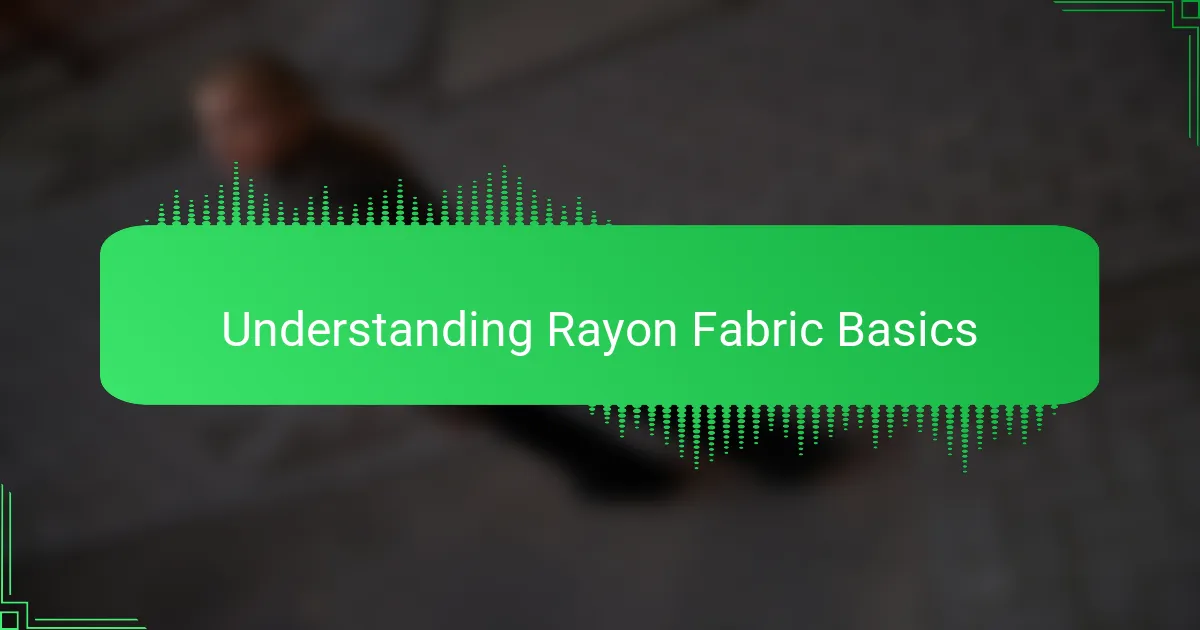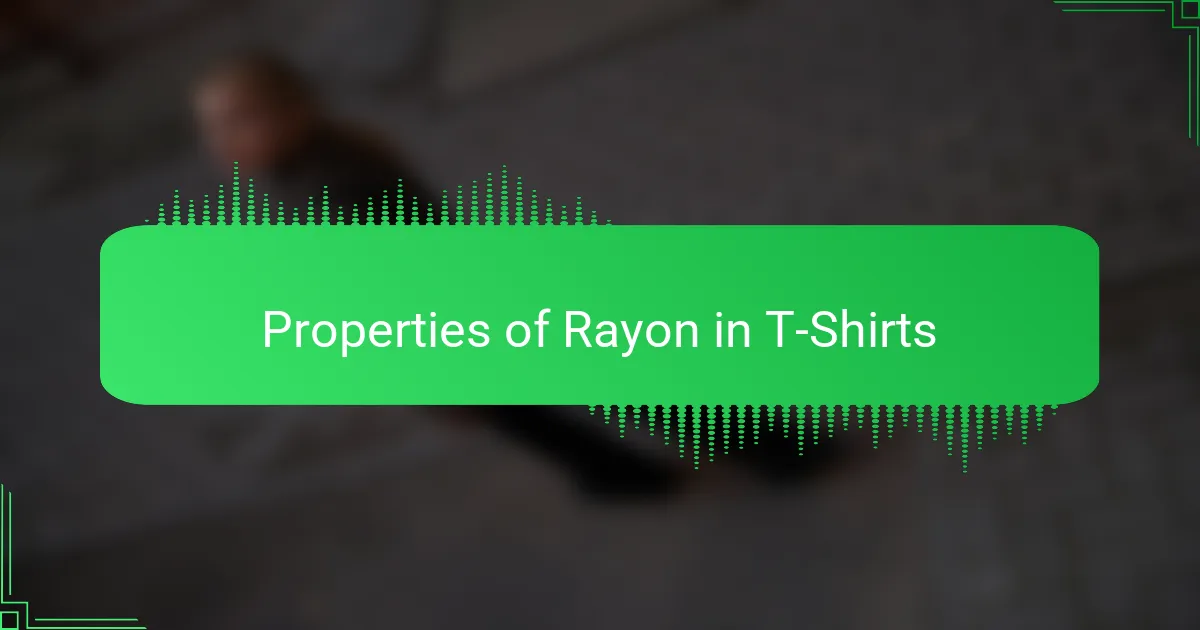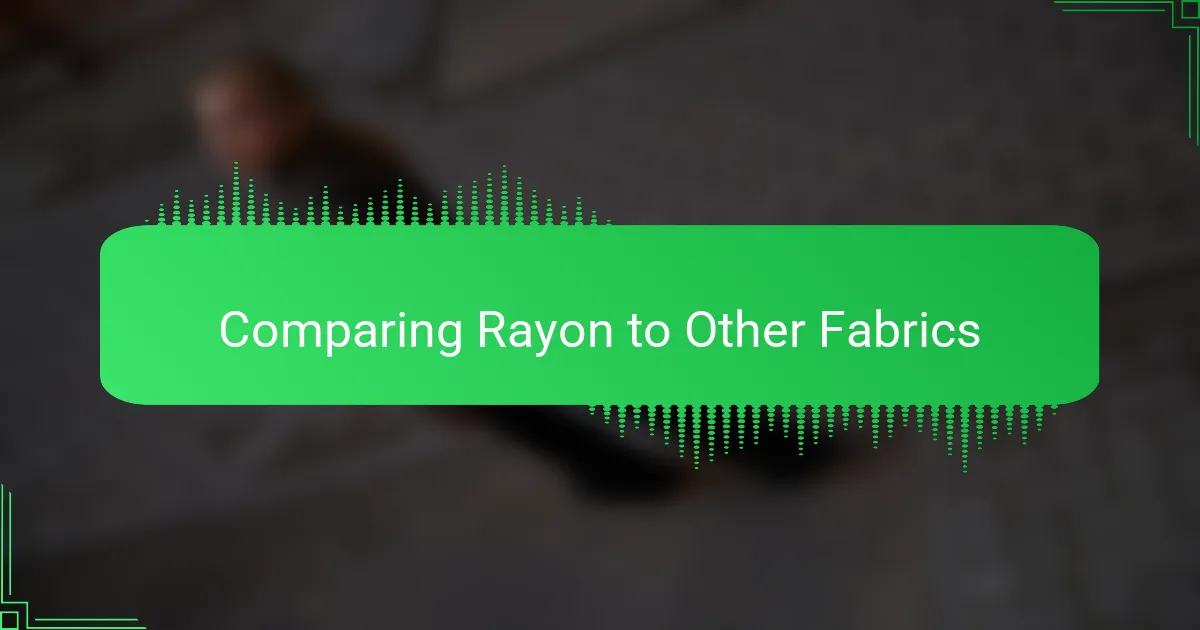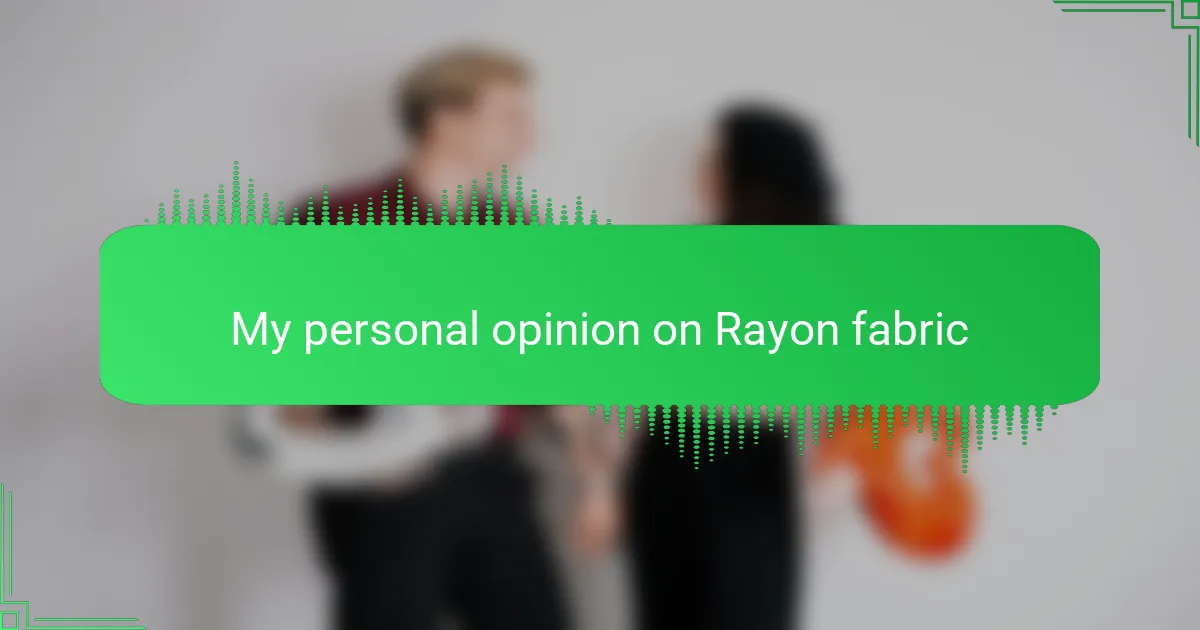Key takeaways
- Rayon is a semi-synthetic fabric made from cellulose, offering a smooth, breathable feel with a luxurious drape ideal for t-shirt designs.
- While rayon enhances comfort and vibrant dye absorption, it requires delicate care to prevent wrinkling and damage during washing.
- Comparing rayon to other fabrics, it excels in softness and aesthetic appeal, though it may lack durability over time compared to cotton and polyester.
- Effective handling and washing techniques are essential for maintaining rayon’s quality, making the extra effort worthwhile for its unique characteristics.

Understanding Rayon Fabric Basics
Rayon fabric always intrigued me because it’s not quite natural, yet not fully synthetic either. It’s made from cellulose, mostly derived from wood pulp, which gives it that smooth and silky feel I immediately noticed the first time I touched a rayon t-shirt. Have you ever wondered how something can feel so soft and breathable but still have the versatility of a man-made fabric?
What really struck me is how rayon adapts in its texture and weight depending on how it’s woven, making it ideal for t-shirt design where comfort and drape matter so much. I remember experimenting with rayon blends in my early design days and being surprised by how well it handled dyes, producing vibrant colors that just pop. That kind of quality can really elevate a basic tee into something special, don’t you think?
Yet, understanding rayon means also knowing it requires a bit of care—it can wrinkle easily and may need gentle washing. This makes me wonder if the extra effort is worth it for a fabric that feels this good against the skin. In my experience, the tactile reward definitely justified the maintenance, especially when designing pieces meant to feel personal and luxurious.

Properties of Rayon in T-Shirts
One thing that always stands out to me about rayon in t-shirts is its incredible breathability. When I wear a rayon tee on a warm day, I notice how it lets air flow through, making me feel cooler than cotton or polyester might. Have you ever experienced that light, almost breezy feeling against your skin? That’s rayon doing its job beautifully.
Another property that I find fascinating is how rayon drapes. Unlike stiffer fabrics, rayon falls softly and fluidly, giving t-shirts a relaxed, flattering silhouette. I remember designing a simple rayon t-shirt and being amazed at how it moved with the body, almost like a second skin. It really makes a difference in both comfort and style.
However, rayon’s softness comes with a trade-off—it tends to wrinkle more easily than other fabrics. I’ve caught myself ironing my favorite rayon tees more times than I’d like to admit, but honestly, the luxurious feel against my skin makes it worth the effort. Doesn’t that little wrinkle seem like a small price to pay for such comfort?

Comparing Rayon to Other Fabrics
When I compare rayon to cotton, what stands out most is its softness and sheen. Cotton tees feel sturdy and breathable, sure, but rayon’s silky texture often gives a more upscale vibe that cotton sometimes lacks. Have you ever touched a fabric and instantly thought, “This feels different—almost luxurious?” That’s usually rayon talking.
Polyester, on the other hand, is often praised for durability and wrinkle resistance, which is something I really appreciate in everyday wear. But when I think about how polyester feels against my skin, it never quite matches the natural drape and comfort I get with rayon. It’s like choosing between practicality and that special softness that makes a shirt feel personal.
Blends involving rayon capture the best of both worlds in my experience. I recall designing a t-shirt that mixed rayon with a bit of spandex, and the result was incredible: softness, stretch, and shape retention all in one. Isn’t that the sweet spot we look for when designing tees that people want to wear again and again?

Benefits of Rayon for T-Shirt Design
Rayon’s breathability truly makes it a standout for t-shirt design in my book. I remember wearing a rayon tee during a summer hike and was amazed at how cool and comfortable I felt, even when the sun was beating down. Isn’t it great when your clothing actually helps you stay comfortable instead of adding to the heat?
Another benefit I appreciate is how well rayon takes dye, which opens up endless possibilities for vibrant and eye-catching t-shirt designs. When I first printed on a rayon shirt, the colors seemed brighter and more vivid than I expected, giving the design a life of its own. Doesn’t that ability to hold color make a huge difference when you want your designs to really pop?
What I find especially rewarding is rayon’s drape — it gives t-shirts a natural, flattering flow that feels effortless. Designing tees that move with the wearer and don’t cling awkwardly is always a challenge, but rayon makes it easier. Have you noticed how some fabrics just hug your body in all the wrong places? Rayon avoids that completely, making it a joy to design with.

Challenges When Using Rayon
One challenge I’ve often encountered with rayon is its tendency to wrinkle rather easily. I remember the frustration of packing a favorite rayon tee for a trip, only to find it looking crumpled out of the suitcase. Have you ever faced that moment when your carefully designed shirt needs an iron just to look presentable? It’s a bit of a nagging inconvenience, but knowing how soft and luxurious the fabric feels makes me willing to put in the extra effort.
Another issue that caught my attention is rayon’s delicate nature when it comes to washing. Unlike sturdy cotton or polyester, you really have to be gentle—cold water, mild detergents, and air drying are a must if you want to avoid shrinkage or damage. I recall once ignoring these care tips and ended up with a shrunken tee that lost its original shape, which was a tough lesson for me as a designer. Does the extra handwashing feel like a hassle? Sometimes yes, but I think the payoff in comfort and look is worth it.
Lastly, I’ve noticed rayon can sometimes be less durable over time compared to other fabrics. My personal experience has been that repeated wear and washing can cause thinning or pilling sooner than I’d like. It made me question if rayon is the best choice for everyday tees, but then again, for special designs meant to feel personal and high-quality, its softness and drape still win me over. Have you weighed durability against comfort when choosing fabric? It’s a tricky balance I keep mulling over.

My Experience Designing with Rayon
Designing with rayon introduced me to a whole new set of feelings about fabric. I remember the first time I sketched a tee and then saw it brought to life with rayon—it draped exactly as I’d imagined, flowing gently over the form in a way that felt almost alive. Have you ever had that moment when your vision finally matches the material? For me, rayon made that possible in a way cotton never did.
One detail that caught me off guard was how carefully I had to handle rayon during the design process. Cutting and sewing demanded more precision because the fabric can slip or stretch unexpectedly. It felt like working with something delicate yet rewarding, reminding me to slow down and appreciate the tactile connection between design and material. Does that kind of hands-on involvement make the final product feel more personal to you, too?
Yet, the real joy came when the designs got a chance to breathe in the real world. I crafted a series of casual tees where rayon’s softness and sheen turned simple concepts into pieces that customers kept coming back for. Seeing that response made me realize how much the fabric’s unique qualities can elevate even the simplest t-shirt, giving it a subtle but unmistakable elegance. Wouldn’t you agree that the right fabric can truly transform a design from ordinary to memorable?

Tips for Working with Rayon T-Shirts
When working with rayon t-shirts, I’ve found that handling the fabric gently makes all the difference. Since rayon is prone to stretching and slipping while cutting, taking a little extra time to pin and stabilize the fabric helped me avoid frustrating mistakes. Have you ever felt that slight tug and realized your material isn’t cooperating? That’s rayon reminding you to slow down and be precise.
Washing rayon tees carefully is another tip I always emphasize. I learned the hard way that cold water and mild detergents are key to preserving the fabric’s softness and shape. Throwing a rayon shirt into the wash with harsh detergents can quickly lead to shrinkage or damage — definitely not what you want after putting effort into your design. Isn’t it worth the extra care for that luxurious feel?
Finally, ironing rayon requires some patience but rewards you with a polished look. I usually use a low heat setting and press the tee inside out to avoid shine or scorching. Wrinkles can be stubborn, but a little attention here brings the fabric back to life beautifully. Have you noticed how those smooth surfaces can make your designs really stand out? That small effort makes rayon t-shirts feel special every time.
